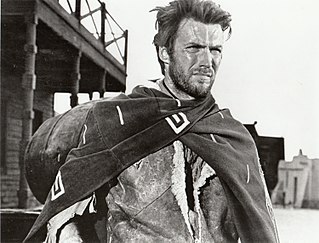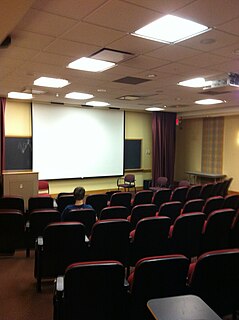Related Research Articles

A film genre is a stylistic or thematic category for motion pictures based on similarities either in the narrative elements, aesthetic approach, or the emotional response to the film.

Herbert Marshall McLuhan was a Canadian philosopher whose work is among the cornerstones of the study of media theory. Born in Edmonton, Alberta, and raised in Winnipeg, Manitoba, McLuhan studied at the University of Manitoba and the University of Cambridge. He began his teaching career as a professor of English at several universities in the United States and Canada before moving to the University of Toronto in 1946, where he remained for the rest of his life.
Media studies is a discipline and field of study that deals with the content, history, and effects of various media; in particular, the mass media. Media Studies may draw on traditions from both the social sciences and the humanities, but mostly from its core disciplines of mass communication, communication, communication sciences, and communication studies.

Raymond Henry Williams was a Welsh socialist writer, academic, novelist and critic influential within the New Left and in wider culture. His writings on politics, culture, the media and literature contributed to the Marxist critique of culture and the arts. Some 750,000 copies of his books were sold in UK editions alone, and there are many translations available. His work laid foundations for the field of cultural studies and cultural materialism.
Media ecology theory is the study of media, technology, and communication and how they affect human environments. The theoretical concepts were proposed by Marshall McLuhan in 1964, while the term media ecology was first formally introduced by Neil Postman in 1968.

Understanding Media: The Extensions of Man is a 1964 book by Marshall McLuhan, in which the author proposes that the media, not the content that they carry, should be the focus of study. He suggests that the medium affects the society in which it plays a role mainly by the characteristics of the medium rather than the content. The book is considered a pioneering study in media theory.

Film studies is an academic discipline that deals with various theoretical, historical, and critical approaches to cinema as an art form and a medium. It is sometimes subsumed within media studies and is often compared to television studies.

Henry Jenkins III is an American media scholar and Provost Professor of Communication, Journalism, and Cinematic Arts, a joint professorship at the University of Southern California (USC) Annenberg School for Communication and Journalism and the USC School of Cinematic Arts. He also has a joint faculty appointment with the USC Rossier School of Education. Previously, Jenkins was the Peter de Florez Professor of Humanities as well as co-founder and co-director of the Comparative Media Studies program at the Massachusetts Institute of Technology (MIT). He has also served on the technical advisory board at ZeniMax Media, parent company of video game publisher Bethesda Softworks. In 2013, he was appointed to the board that selects the prestigious Peabody Award winners.
Mobile privatization can be described as an individual's attachment to a mobile device. This leads to a feeling of being "at home" while connected to a device in a mobile setting. Using a mobile device, an individual can feel as though they could travel anywhere in the world while still feeling comfortable because of the connectivity of their mobile device. The connection creates a sense of familiarity, resulting in the individual's identity becoming attached to their mobile service provider. This concept leads to the idea that "home" does not need to be a domestic structure featuring walls and a roofA House, but that the mobile sense of connection provides a portable community similar to a home environment.
Television studies is an academic discipline that deals with critical approaches to television. Usually, it is distinguished from mass communication research, which tends to approach the topic from a social sciences perspective. Defining the field is problematic; some institutions and syllabuses do not distinguish it from media studies or classify it as a subfield of popular culture studies.
Media psychology is the branch and specialty field in psychology that focuses on the interaction of human behavior with media and technology. Media psychology is not limited to mass media or media content; it includes all forms of mediated communication and media technology-related behaviors, such as the use, design, impact, and sharing behaviors. This branch is a relatively new field of study because of advancement in technology. It uses various methods of critical analysis and investigation to develop a working model of a user's perception of media experience. These methods are used for society as a whole and on an individual basis. Media psychologists are able to perform activities that include consulting, design, and production in various media like television, video games, films, and news broadcasting. Media psychologists are not considered to be those who are featured in media, rather than those who research, work or contribute to the field.
Medium theory is a mode of analysis that examines the ways in which particular communication media and modalities impact the specific content (messages) they are meant to convey. Medium theorists argue that media are not simply channels for transmitting information between environments, but are themselves distinct social-psychological settings or environments that encourage certain types of interaction and discourage others.
John Hartley,, FAHA,, ICA Fellow, an academic, is a John Curtin Distinguished Emeritus Professor. He was formerly Professor of Cultural Science and the Director of the Centre for Culture and Technology (CCAT) at Curtin University in Western Australia, and Professor of Journalism, Media and Cultural Studies at Cardiff University. He has published over twenty books about communication, journalism, media and cultural studies, many of which have been translated into other languages. Hartley continues with CCAT as an adjunct professor.
Joshua Meyrowitz is a professor of communication at the department of Communication at the University of New Hampshire in Durham. He has published works regarding the effects of mass media, including No Sense of Place: The Impact of Electronic Media on Social Behavior, an analysis of the effects various media technologies have caused, particularly television.

The sociology of literature is a subfield of the sociology of culture. It studies the social production of literature and its social implications. A notable example is Pierre Bourdieu's 1992 Les Règles de L'Art: Genèse et Structure du Champ Littéraire, translated by Susan Emanuel as Rules of Art: Genesis and Structure of the Literary Field (1996). For a concise overview of the "state-of-the-art" of the sociology of literature, look at Váňa (2020).

Culture is an umbrella term which encompasses the social behavior and norms found in human societies, as well as the knowledge, beliefs, arts, laws, customs, capabilities, and habits of the individuals in these groups.
Cultural studies is an interdisciplinary field that examines the political dynamics of contemporary culture and its historical foundations. Cultural studies researchers generally investigate how cultural practices relate to wider systems of power associated with, or operating through, social phenomena. These include ideology, class structures, national formations, ethnicity, sexual orientation, gender, and generation. Employing cultural analysis, cultural studies views cultures not as fixed, bounded, stable, and discrete entities, but rather as constantly interacting and changing sets of practices and processes. The field of cultural studies encompasses a range of theoretical and methodological perspectives and practices. Although distinct from the discipline of cultural anthropology and the interdisciplinary field of ethnic studies, cultural studies draws upon and has contributed to each of these fields.

New media studies is an academic discipline that explores the intersections of computing, science, the humanities, and the visual and performing arts. Janet Murray, a prominent researcher in the discipline, describes this intersection as "a single new medium of representation, the digital medium, formed by the braided interplay of technical invention and cultural expression at the end of the 20th century".The main factor in defining new media is the role the Internet plays; new media is effortlessly spread instantly. The category of new media is occupied by devices connected to the Internet, an example being a smartphone or tablet. Television and cinemas are commonly thought of as new media but are ruled out since the invention was before the time of the internet.
Global cultural flow involves the flow of people, artifacts, and ideas across national boundaries as result of globalization. Global cultural flows can be observed in five interdependent 'Landscapes', or dimensions, that distinguish the fundamental disjunctures between economy, culture, and politics in the global cultural economy.
Audience flow describes how people move through media offerings in a temporal sequence. Stable patterns of audience flow were first identified in the early twentieth century when radio broadcasters noticed the tendency of audiences to stay tuned to one program after another. By the 1950s, television audiences were demonstrating similar patterns of flow. Not long thereafter, social scientists began to quantify patterns of television audience flow and its determinants. Audience flow continues to characterize linear media consumption. Newer forms of nonlinear media evidence analogous patterns of “attention flow.”
References
- ↑ Raymond Williams (2004/1974) Television. Technology and Cultural Form. London: Routledge, p. 86
- ↑ Quoted in Robert Fink, Repeating Ourselves: American Minimal Music as Cultural Practice (Berkeley: University of California Press, 2005), 132. ISBN 0-520-24550-4
- ↑ Raymond Williams (2004/1974) Television. Technology and Cultural Form. London: Routledge, p. 89
- 1 2 3 Rick Altman, "Television/Sound," in Studies in Entertainment: Critical Approaches to Mass Culture ed. Tania Modleski (Bloomington: Indiana University Press, 1986), 39-54.